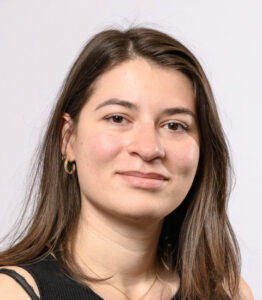Meet the poster prizes winners of the EMBO | EMBL Symposium ‘Infection: pathogens, hosts, and microbiomes’
The EMBO | EMBL Symposium ‘Infection: pathogens, hosts, and microbiomes‘ took place last month at EMBL Heidelberg and virtually.
The recent past has shown us that the modern lifestyle, antimicrobial resistance, and global warming will make epidemics and pandemics an even greater challenge in the future. To develop new strategies for addressing current limitations in our ability to treat infections, the symposium brought together experts working on various pathogens – including viruses, bacteria, fungi, and parasites – to share innovative technologies and knowledge across different fields. The topics covered a wide range, including the structural aspects of infection, pathogen analysis, pathogen-cell interactions, pathogen-tissue interactions, the microbiome, and evolution.
During the three-day conference, there were 101 on-site and 49 virtual participants. The EMBL Corporate Partnership Programme and EMBO provided six fellowships. With 45 posters presented, we held two poster sessions, and participants voted for five winners. We are pleased to share four of the abstracts with you.
Segmented filamentous bacteria are motile
Presenter: Alice Daniau
Authors: Alice Daniau, Agnès Legrand, Son Phan, Marie Anselmet, Jean-Yves Tinevez, Pablo Vargas, Pamela Schnupf

Institut Necker Enfants Malades (INEM), France
Abstract:
Segmented Filamentous Bacterium (SFB) are a unique class of intestinal bacteria present in the gut mucosa-associated microbiota of a wide range of vertebrates. SFB exhibit critical effects on the education and maturation of the gut innate and adaptive immune system due to their intimate attachment to the ileal surface. Attachment to the host is mediated by the unicellular form, called intracellular offsprings (IOs). These grow out into long pluricellular filaments that release flagellated IOs from their distal end. For attachment to occur, IOs need to reach their replicative niche, the epithelial surface. Our previous demonstration of flagella on IOs, using transmission electron microscopy, suggested a likely ability for motility, but motility has not yet been described. Here, we characterized the motility and kinetics of SFB IOs using video microscopy and microfluidics devices. Purification of SFB from monocolonized mice and restriction of SFB IOs into custom microfluidics channels, with various viscosity settings, allowed video recording of SFB IOs. Trajectories were analyzed through particle tracking bioinformatics (Trackmate, ImageJ plugin) and metrics such as speed, acceleration, rotation rate and oscillation were quantitated through the development of in-house pipelines. IOs were found to display substantial motility and to exhibit different types of trajectories, including circle clockwise (CW), circle counterclockwise (CCW), straight runs, and run and tumble. In addition, the motility behavior of IOs was modified as medium viscosity was increased. Our results reveal a broad range of motility capabilities for IOs in both fluid and viscous environments in line with their expected ability to cross the mucus layer in order to attach to the host epithelium. We thereby provide critical insights into a likely essential part of the SFB life-cycle and the interaction of this peculiar and still enigmatic bacterium with its host.
Due to the confidentiality of the unpublished data, we cannot share the poster
– Kindly supported by PLOS Biology
Structural and functional insights into the mycobacterial type VII secretion systems
Presenter: Zhuoyan Chen
Authors: Zhuoyan Chen, Edukondalu Mullapudi, Grzegorz Chojnowski, Matthias Wilmanns

EMBL Hamburg, Germany
Abstract:
Mycobacteria rely on the type VII secretion system to translocate a range of virulence that are essential for various functions, including nutrient uptake, DNA transfer, and immune modulation. They possess up to five paralogous ESX loci encoding for a functional translocon system. Our recent research provides new insights into the structural features of the ESX-4 secretion apparatus using single-particle cryo-EM. High-resolution structures of the Mycobacterium abscessus ESX-4 translocon complex, observed in different apparent molecular weights, reveal a dimeric architecture with a MycP-bound conformation in common feature but substantially differ in visible complex subunit composition. In only one of these structures does the complete EccE subunit become visible. This subunit of the M. abscessus ESX-4 translocon complex differs significantly from equivalent subunits in related ESX complexes with known structures. The limited interactions of EccE with other subunits in the transmembrane segment may explain its invisibility in other conformations of this complex and other ESX translocon complexes, suggesting a transient binding nature. An additional domain at the proximal cytosolic EccC(EccD)₂EccE subcomplex reveals anundiscovered function of positioning some distal EccC ATPase domains. As the dimeric ESX-4 assembly significantly deviates from the expected geometry required for hexameric pore formation, it becomes evident that the found dimeric assembly serves a functional role, which in turn requires major conformational adjustments for hexameric pore formation. This process presumably goes along with an increased level of pore opening that is required for folded substrate translocation. Secretion data on structure-based mutants confirm the way how different subunits interact in these complexes. By comparing the available ESX-3 and ESX-5 structures, we provide an advanced mechanistic model on the molecular parameters of ESX complex assembly and required conformational changes that mediate secretion.
Due to the confidentiality of the unpublished data, we cannot share the poster
Intracellular bacterial communities of uropathogens in urinary tract infections
Presenter: Marlen Petersen
Authors: Marlen Petersen, Gregor Weiss

ETH Zürich, Switzerland
Abstract:
Urinary tract infections (UTIs) are the most common bacterial infection in adults worldwide and the causative agent in ~85% of cases is uropathogenic Escherichia coli (UPEC). Among UTI patients, 25% will be diagnosed with a recurrent UTI within 6 months post initial infection. There is evidence that recurrent UTIs are favored though a highly organized intracellular lifecycle that helps UPEC to survive urine flow, antibiotics, neutrophil attacks and the lack of nutrients in the bladder lumen. The first step of the UPEC infection cycle in the bladder lumen is the internalization into umbrella cells, where UPEC break out into the host cytosol and rapidly form closely packedm intracellular bacterial communities (IBCs). Some highly motile UPEC can then flux out of the epithelial cell and initiate a new infection cycle. Additionally, infected umbrella cells can be exfoliated and washed out with the urine flow. A high number of exfoliated cells have been found in urine of UTI patients of which some still contained intracellular UPEC. A full understanding of the underlying cellular dynamics during the formation of these protective architectures is still missing. These shortcomings are mainly due to the lack of suitable model organisms but also integrative imaging techniques. Therefore, we investigate the macromolecular structure of IBC directly in patient-derived urine samples with correlative cryo-light and electron microcopy. Cryo-electron tomography acquires high resolution 3D images of cell-cell interactions in infected urothelial cells in a life-like state. To date, tomograms revealed intracellular bacteria in all states of the described intracellular lifecycle with known virulence factors such as pili and flagella. However, an extensive biofilm-like matrix in IBCs has not been observed. As we analysed over 100 urine samples, we will establish a dataset correlating the pathogen with the discovered virulence factors to point out differences in the overall architecture and macromolecular composition of IBCs. By integrating the clinical history of individual patients, we will distinguish individual patient-derived factors promoting a bacterial (re-)infection. Thus, the results of this study will give unprecedented insights into UPEC’s strategy to evade host defenses and antibiotic treatments.
Due to the confidentiality of the unpublished data, we cannot share the poster
Development of an advanced nasopharyngeal organ-on-chip system with accurate airflow patterns for the study of airborne bacterial infections
Presenter: Sophie Oatley
Authors: Sophie Oatley, Samy Gobaa, Michael Connor

Institut Pasteur, France
Abstract:
Studying the infection processes of aerosolised pathogens is extremely challenging due in large part to the difficulty in accurately modelling the respiratory tract in vitro. Previously developed in vitro models lacked the integration of important parameters such as aerosolization, air-liquid interface, bidirectional airflow and accurate turbinate specific geometry. Our objective is to develop a physiological nasal in vitro device that models bacterial infection at the nasal barrier. We used 3D printing techniques with biocompatible resin, allowing for a low cost, customisable system that can capture specific aspects of the in vivo nasal passage. We numerically modelled and then microfabricated multiple nasal turbinate geometries to produce sub-millimetre scale airflow patterns. We ensured that the produced microfluidic device is compatible with cell perfusion and live cell imaging. Our device is advantageous over commercial systems (Transwell and Emulate technology) as it allows accurate modelling of the complex airflow patterns in the nasal passage, it can be customised at low cost, and it has the capacity for many devices to run in parallel for high throughput testing. We are using our OoC system for comparative bacterial challenge studies, which compare pneumococcal isolates of varying disease and carriage potential as well as the nasal commensal Corynebacterium accolens to determine the molecular processes that shape the nasal barrier – bacterial interface and their effect on bacterial transmigration, shedding and tissue level inflammatory response.
– Kindly supported by Wiley
The EMBO | EMBL Symposium ‘Infection: pathogens, hosts, and microbiomes’ took place from 26 – 28 May 2025 at EMBL Heidelberg Advanced Training Centre and Virtual.